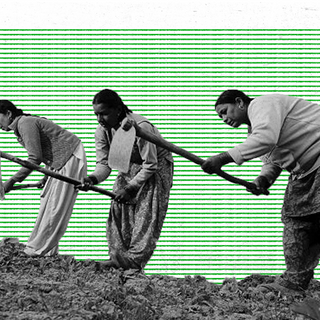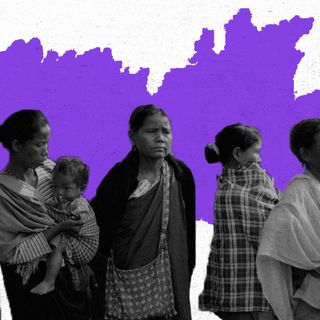
Child Rights Body Probes MP Village Ritual Parading Minor Girls to Desperately ‘Evoke’ Rain
The incident is telling of the complex relationship between climate severity and superstition in an agrarian culture like India.

The Baniya village in Madhya Pradesh’s Bundelkhand district is facing an acute drought. For desperate locals, one superstitious way to invoke rains and seek relief was to make minor girls walk naked around the village to please the rain god. The ritual, documented through videos on social media, has raised concerns about sexual abuse and child rights.
As seen on the video, six girls, believed to be around five years old, walked to different households begging for pulses, food cereals, and flour. A wooden shaft sits on their shoulder with a frog on top; the procession involves a group of women singing devotional songs.
“We believe that this will bring in rains,” the women are heard singing in the clipping, seemingly taking blessings to save the dying paddy crops in the region.
On Tuesday, the National Commission for Protection of Child Rights (NCPCR) sought a probe from the Damoh district administration. The ritual is happening for the last few days, according to a Times of India report.
“In such cases, the administration can only make the villagers aware about the futility of such superstition and make them understand that such practices don’t yield desired results,” Damoh superintendent of police D.R. Teniwar told PTI. He added the police will take action if it is found children were forcefully made to participate. The instance invited strong rebuke from people for its disregard of human rights and dignity, along with exploiting children.
The village is located 50 km from Damoh, where the specter of drought has triggered desperate pleas. The invocation of rain through music and rituals in tribal areas is a longstanding tradition; also capturing the anxiety over monsoon has persisted since ancient times. It is documented in history and folklore, oral stories, and news reports — and becomes part of a community’s value system.
The ritual is telling of two aspects: the socio-cultural aspects of climate suffering in agrarian economies like India, and the prominent role women play in giving credence to these practices. Women also figure prominently in such rituals owing to beliefs of connection with nature and fertility.
“Man’s desperation for rain can be viewed in the extreme measures he’s willing to take,” Mayank Kumar wrote in his book Monsoon Ecologies.
Related on The Swaddle:
It’s No Mystery That Superstition Is Behind India’s High Snakebite Deaths
Madhya Pradesh, along with other states, is not unfamiliar with such rituals. In Chhatarpur village, people wed two frogs to invoke rainfall. The ritual, called Bhekul Biye in Assam and surrounding regions, is among many others. In Jharkhand, for instance, rituals usually involve Dalit men, who roll over thorns to ask the gods for forgiveness for any sins. 100 female camels are sacrificed in Rajasthan or unwed women plow the field naked at night as a means to shame the Hindu mythological figure, Indra, considered the god of rain, for the lack of rainfall.
Why these rituals continue to thrive is not unsurprising. First and foremost, it is the absolute helplessness in rain-parched regions. Relying on gender and tribal stereotypes, such as ones about gender, work to assuage the despair of a community then.
Another reason could be that these rituals become part of the “realm of the popular,” Delhi-based historian Shashank Shekhar Sinha notes. “The ‘domain of the popular’ is numerically bigger than the ‘domain of the modern’ and like the latter, it has its own narratives, rhythms, understandings, and politics,” he told The Indian Express.
The narrative of superstition and values forms a tenuous root to these ideologies. “Although all of these sayings may sound superstitious, they did represent a complex web of meanings and values, which the rural folk attached to different phenomena of nature,” Kumar adds. Some theorists argue these instances should be viewed as traditions from a cultural perspective, instead of being denigrated.
It is important to note there is limited scientific evidence to verify these processions. In 2018, there was a protest against the frog marriage as a public official was present at the event; activists thought his presence lent “rationality” to such superstitions. Moreover, these rituals amplify gender and power hierarchies evident in societies. Unwed women marching naked or Dalit men lying in the mud as a way to purge their sins symbolize the extent to which the marginalized body is objectified and sacrificed in the name of culture.
The recent incident in Madhya Pradesh borders on the abusive nature these instances can take. Reports note the minor girls were not aware of why these rituals took place. It is hard to take action since they were conducted with the consent of the families. The specter of little girls being paraded naked, begging from door-to-door, is chilling. It demands a higher-level probe about protecting child rights and abuse.
In the end, the incident betrays the complex relationship between science and superstition. This is an interrogation that will gain importance as climate-related drought and delayed rainfalls will only increase in severity. It poses a profound question: how does one straddle the thin line between consent and belief systems?
Saumya Kalia is an Associate Editor at The Swaddle. Her journalism and writing explore issues of social justice, digital sub-cultures, media ecosystem, literature, and memory as they cut across socio-cultural periods. You can reach her at @Saumya_Kalia.
Related


Disability Rights Activists Oppose ‘Discriminatory’ Clause in Nursing Schools
